AI Social Media Analytics: How AI Is Reshaping Social Strategies
Transform your social media marketing with AI analytics. Get real-time insights, predict content performance, automate competitor analysis, and boost ROI with data-driven strategies.

I’ve always believed the best marketing doesn’t talk at people. It listens first. That’s why I found Mercedes-Benz’s “The Moody Colors of Poland” campaign so clever.
They used an AI tool to scan platforms like Instagram, Twitter, Facebook, and even blogs, tracking emotion-specific keywords and hashtags like #joy, #love, #sadness, and more. Based on this analysis, they changed the lighting of their showroom and billboards to match the country’s collective mood. One day it was calm green, another day it was energetic yellow.
It’s a perfect example of how AI in social media analytics isn’t just about charts or dashboards. It can translate online behavior into meaningful, actionable insight.
In this guide, I’ll walk you through how you can start using AI-generated analytics to create campaigns, run social media content, and optimize your overall social media marketing strategy.
Key takeaways
-
AI analyzes social media beyond basic metrics - Uses natural language processing to understand sentiment, context, and patterns in real-time, not just likes and shares.
-
Predictive capabilities optimize content strategy - AI forecasts which posts will perform best and recommends optimal timing, formats, and targeting based on historical data.
-
Massive time savings in data analysis - What used to take weeks of manual analysis now happens in seconds, with automated insights and recommendations.
-
Better ROI measurement and targeting - AI connects social media activity to actual business outcomes and creates precise audience segments based on behavior, not just demographics.
-
Unified cross-platform analytics - Consolidates data from multiple social platforms into single dashboards for complete performance visibility.
-
Proactive crisis management - Real-time monitoring flags potential issues through sentiment analysis and unusual mention spikes before they escalate.
-
Automated competitive intelligence - Continuously tracks competitor strategies, content performance, and audience engagement to identify opportunities.
-
Main challenges include data integration, team adoption, and privacy concerns - These can be addressed through gradual implementation and proper training.
What is AI social media analytics?
AI social media analytics uses artificial intelligence to gather, process, and interpret data from social platforms in a way that goes beyond basic metrics like likes or shares.
Key technologies power this behind the scenes. For example, Natural Language Processing (NLP) helps AI interpret human language, slang, and context, while machine learning allows systems to identify patterns and improve over time.
Let’s understand how this might look in real life. Instead of doing a manual check on your last week’s content, you can head to Socialinsider and let AI give you an overview of your content performance for the week.
AI analytics offer businesses transformative insights by analyzing vast amounts of data quickly and accurately. This technology enables companies to make data-driven decisions, predict trends, and optimize operations.
Looking ahead, AI analytics is likely to become more sophisticated, integrating with other advanced technologies such as machine learning and natural language processing. This evolution will enhance predictive capabilities and offer more personalized customer experiences.
As AI continues to advance, businesses that leverage these tools effectively will gain a significant competitive edge, driving innovation and efficiency across various industries.” - Volkan Yolci, Business Developer at Demirören Yatırım Holding
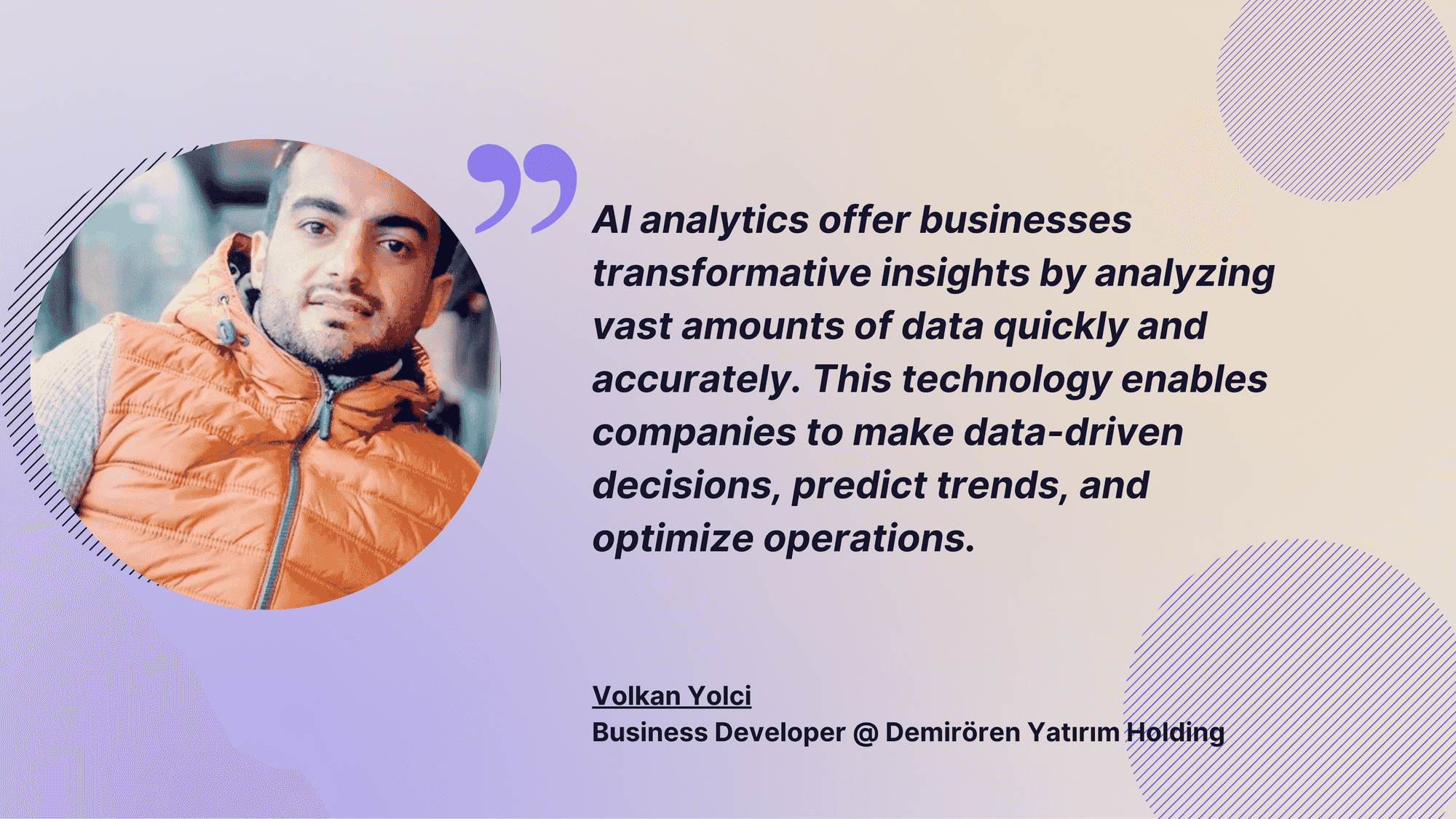
How AI is transforming social media marketing
Below are five ways I am seeing AI be a part of social marketing:
1. Real-time sentiment analysis and monitoring. AI makes it possible to know exactly how people feel about your brand, while they’re still feeling it. Through real-time sentiment analysis, AI scans social media posts the moment they’re published, picking up on tone, keywords, emojis, and even sarcasm (well, it’s trying). Not only that, it picks up on comments and posts where you’re tagged to show the common sentiment towards your brand.
2. Automated content performance prediction. How did your posts perform last week? Did you see an increase in engagement compared to the previous week? AI analytics tools give you an automated analysis of your existing social media content calendar.
The best thing? As AI tools get sharper and stronger, they will also predict how future posts might perform. Based on timing, tone, visuals, hashtags, and audience behavior, you’ll have a data-savvy co-pilot who tells you what to post, when, and why it’ll likely work. Instead of guessing what might engage your audience, AI helps you make smarter, evidence-backed choices that improve consistency and reach.
3. Advanced audience segmentation and targeting. Instead of grouping people by age or location alone, AI analyzes behavior, interests, sentiment, and even how people interact with your content. This helps you show your social media content to the right people. It’s especially useful when you’re running promotions on social media.
Say you’re running a paid campaign for a new eco-friendly skincare line. Instead of just selecting “women, ages 20–40, interested in beauty,” Meta’s AI can go deeper. It analyzes who’s clicked similar ads, who engages with sustainable brands, who watches skincare tutorials all the way through, and who makes purchases after viewing an ad. Based on that, it automatically creates Lookalike Audiences.
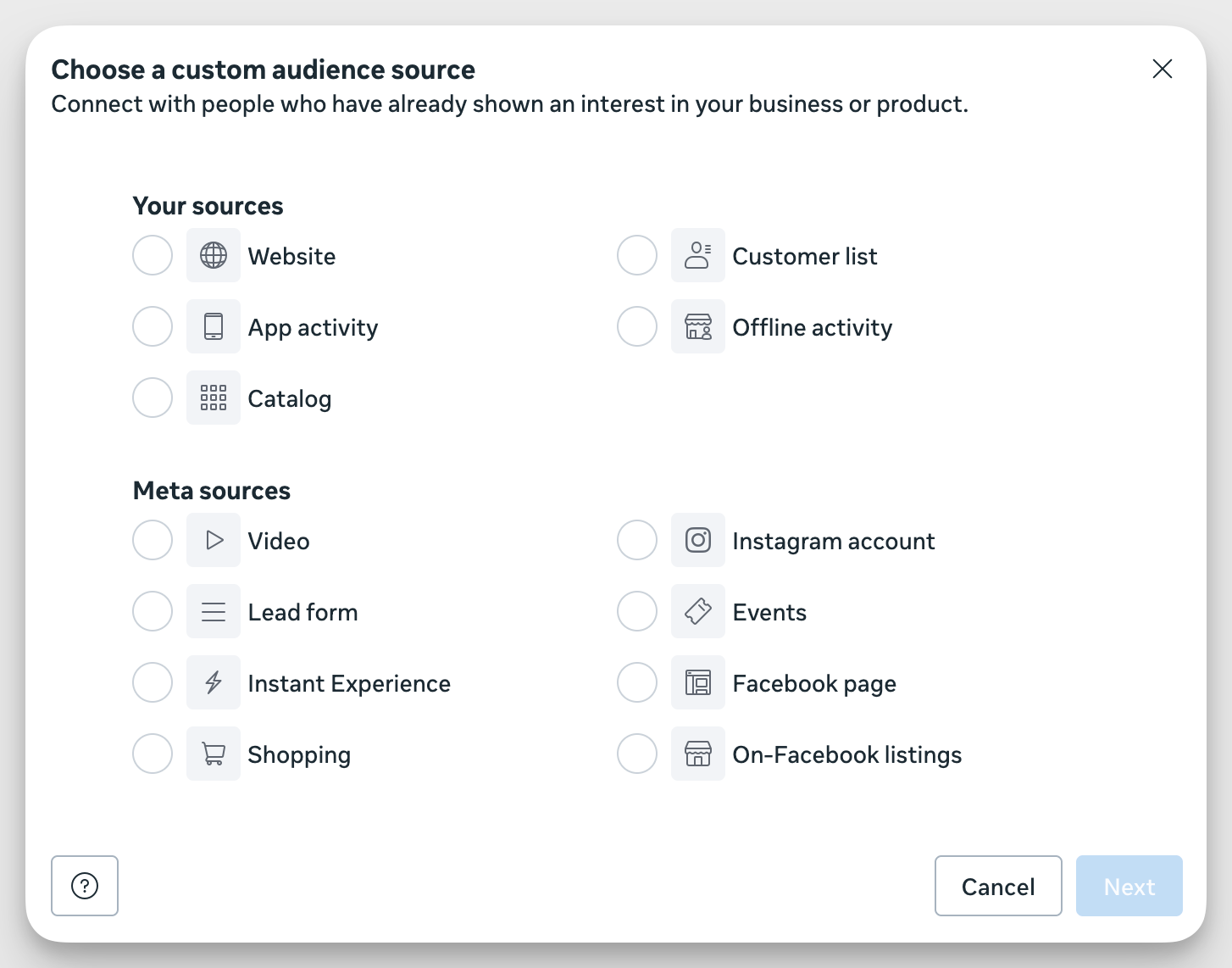
4. Predictive social media trends. What if you could predict which of your posts will perform best, before you even hit publish? AI scans your past content to find what’s worked (and what flopped). It looks at patterns across post types, timing, captions, visuals, hashtags, and engagement metrics to figure out what drives results for your audience.
For example, if your top-performing posts tend to be reels with behind-the-scenes content posted on weekday evenings, AI picks up on that. It then predicts which upcoming content is likely to get the most engagement and recommends tweaks. For example, adjusting post time or using a better-performing format.
5. Cross-platform analytics integration. Tired of hopping between Instagram Insights, X analytics, LinkedIn reports, and a dozen open tabs? AI-powered cross-platform analytics brings all that chaos into one clean, unified view. It pulls data from every major platform, stitches it together, and highlights what actually matters.
For example, Socialinsider lets you track important social media metrics across every platform you’re active on.
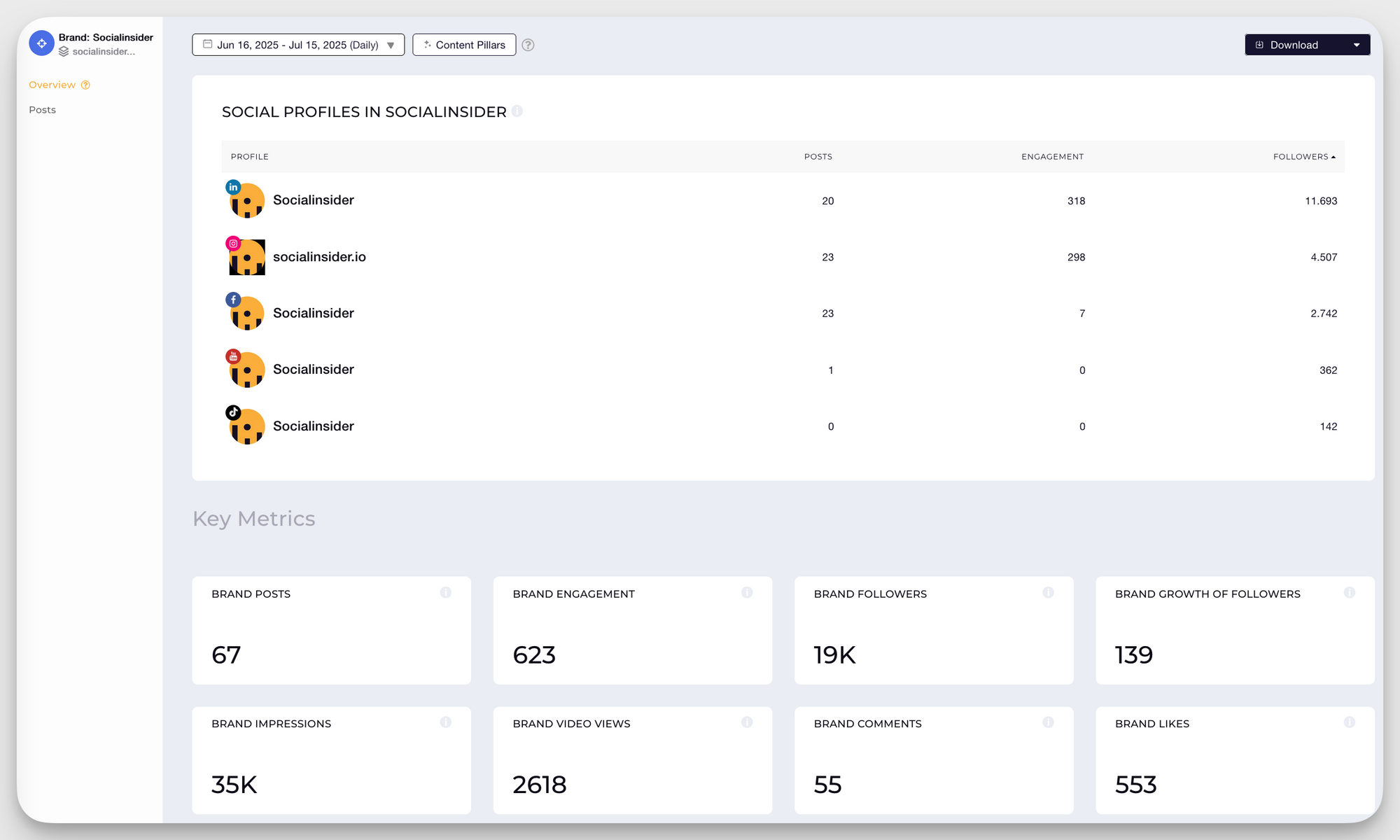
This helps you understand where your audience is hanging out and which social platforms to prioritize.
Key benefits of AI in social media marketing
Is it just time efficiency? Or do you save a lot more when AI comes into the picture? Let’s take a look.
Enhanced speed and efficiency in data processing
Remember the days when you used to take entire days or sometimes weeks to pull data from native analytics or third-party tools? Add another week to pass on that data to your team for analysis.
By the time analysis came in, a lot might have changed. This is what AI helps streamline and streamline fast.
For example, when you add a profile to Socialinsider, you get a ‘Socialinsider Executive Summary’ feature on the top left of the dashboard. Click on it and you get AI-generated recommendations (for owned accounts) or observations (for competitor accounts).
This is what it looks like:
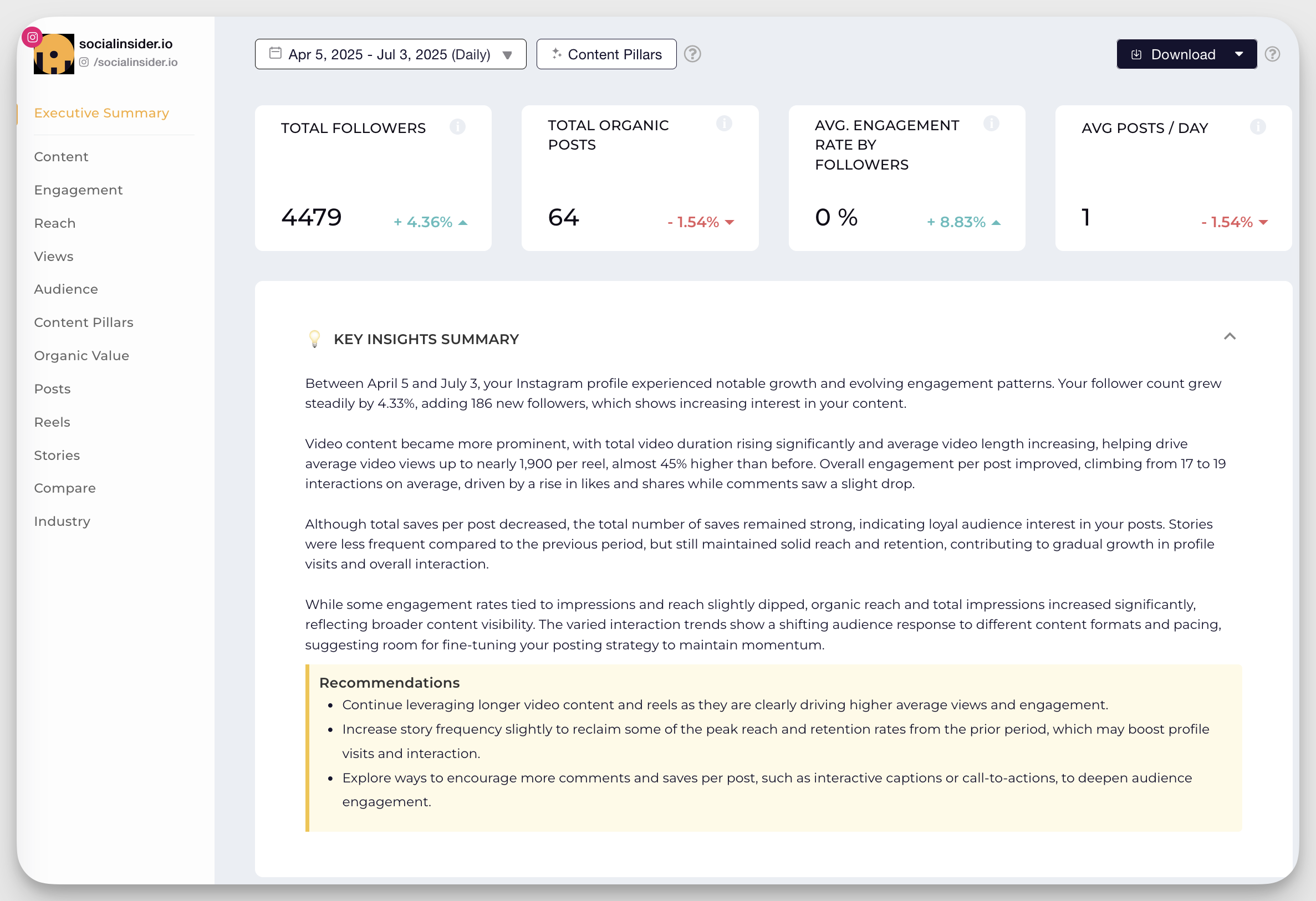
Imagine all those weeks’ work cut down to mere seconds. More importantly, your team is now free to actually work upon those recommendations and experiment with different strategies.
Machine learning algorithms and similar AI tools have been in the toolkit of data analysts for quite some time—they required more intimate knowledge of how they work and expertise to be able to use them. If you weren’t a data scientist, you had no chance to use those tools.
The current state of AI has made it possible to dive into the data easier, with minimum friction—you now get a tool that’s going to make it fun to get more data into your decisions.
As it evolves, analytics will shift from providing the numbers to providing advice and predictions to help you achieve your goals—your very own strategy assistant.” - Andrei Serbanoiu, Co-Founder at Socialinsider
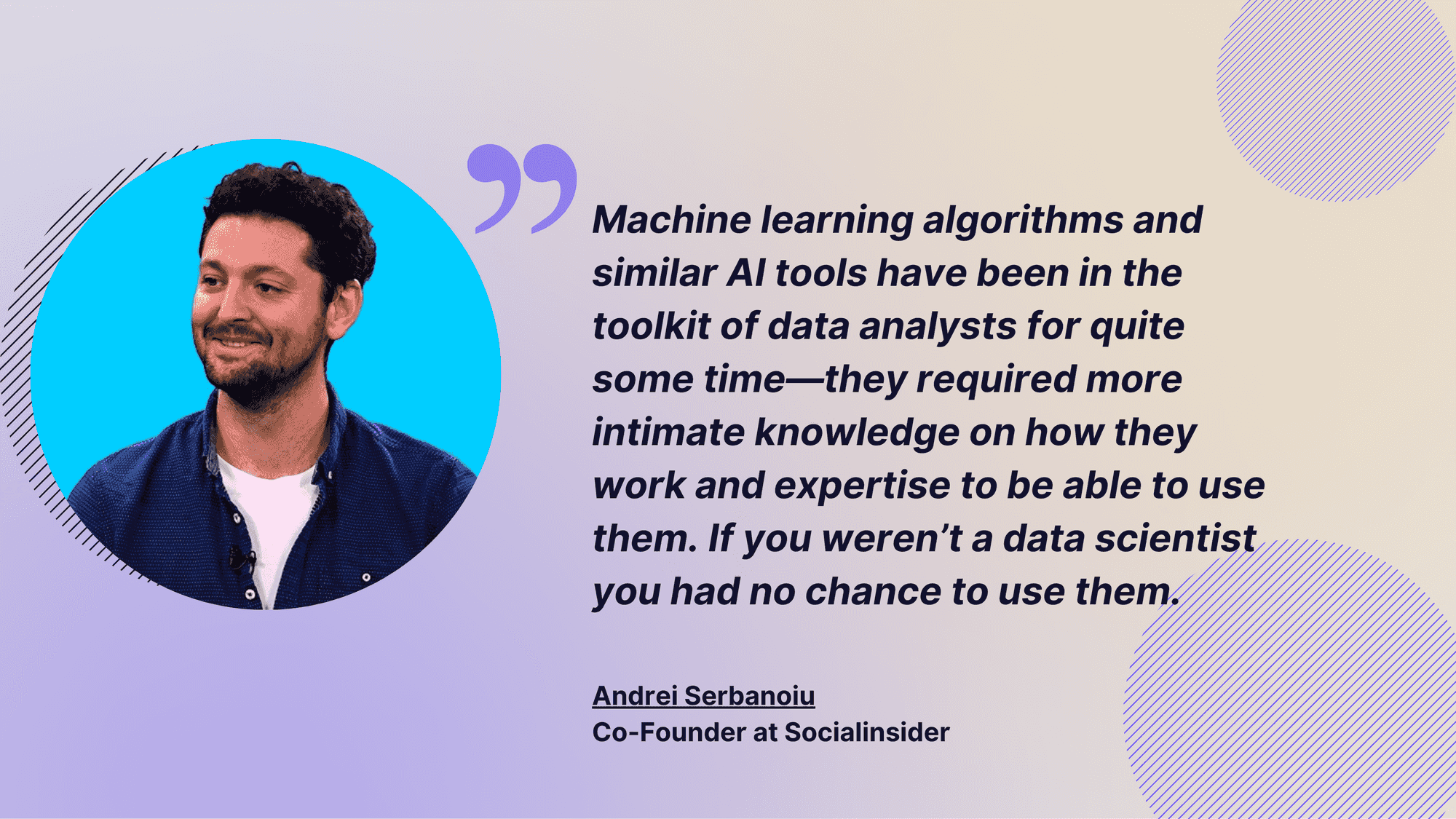
Deeper audience insights and personalization
If you’re running a clothing brand or even a SaaS tool, you’re not targeting just one audience. It could be a mix of audience segments from teens to baby boomers. AI helps you understand these different audience segments.
It digs into how different audiences engage with your content, what they comment on, when they’re most active, and even the kind of tone they respond to.
For example, if you look at Canva, you’ll see they target many audience segments — students, video editors, social media managers, artists, etc. Look at how this collab targets social media managers.

By using AI for marketing, Canva can find what kind of content resonates with different audience segments. Do social media managers like customer stories? Do students like tutorial videos?
Armed with this intel, the brand can personalize content for each segment, right down to format, language, and timing. It’s not creepy. It’s just smart. And way better than throwing one-size-fits-all posts into the void.
Improved ROI measurement and optimization
Measuring ROI on social used to feel like detective work. Lots of guessing, not a lot of clarity. AI fixes that. It connects the dots between your content, audience behavior, ad spend, and actual conversions, so you know what’s driving results and what’s just noise.
Imagine you're running paid posts across Instagram and LinkedIn. AI doesn’t just look at surface metrics like likes or reach, it digs into cost per engagement, watch time, saves, shares, and even sentiment in comments. It can tell you that your Instagram Story ads had lower reach but drove more saves and shares, while LinkedIn video posts had higher engagement from decision-makers.
That means you’re not just measuring which post looked good; you’re seeing which one actually built interest, loyalty, and influence.
Real-time crisis management and response
Ever had that mini heart attack when your brand starts trending, but for the wrong reasons? AI’s got your back. It monitors social media in real time, flagging unusual spikes in mentions, negative sentiment, or keywords tied to potential issues (think “scam,” “glitch,” or “not working”).
Let’s say a product update causes confusion. Instead of finding out two days later from a customer support avalanche, AI alerts you instantly. You can jump in, clarify, apologize, or even meme your way out.
Think about the money and effort you’ll save your brand from because you put out fires early.
Competitive intelligence and benchmarking
How are your competitors performing on social media? Are your metrics faring well against the industry standards? Conducting this research manually will take a lot of time.
With AI analytics tools like Socialinsider, you can benchmark your performance against both competitors and industry leaders, right inside the dashboard.
There are two smart ways to do it. First, use the industry benchmarking feature to compare your metrics (reach, engagement, post types, etc.) against multiple competitors and the broader industry average. You’ll see exactly where you’re leading or lagging.
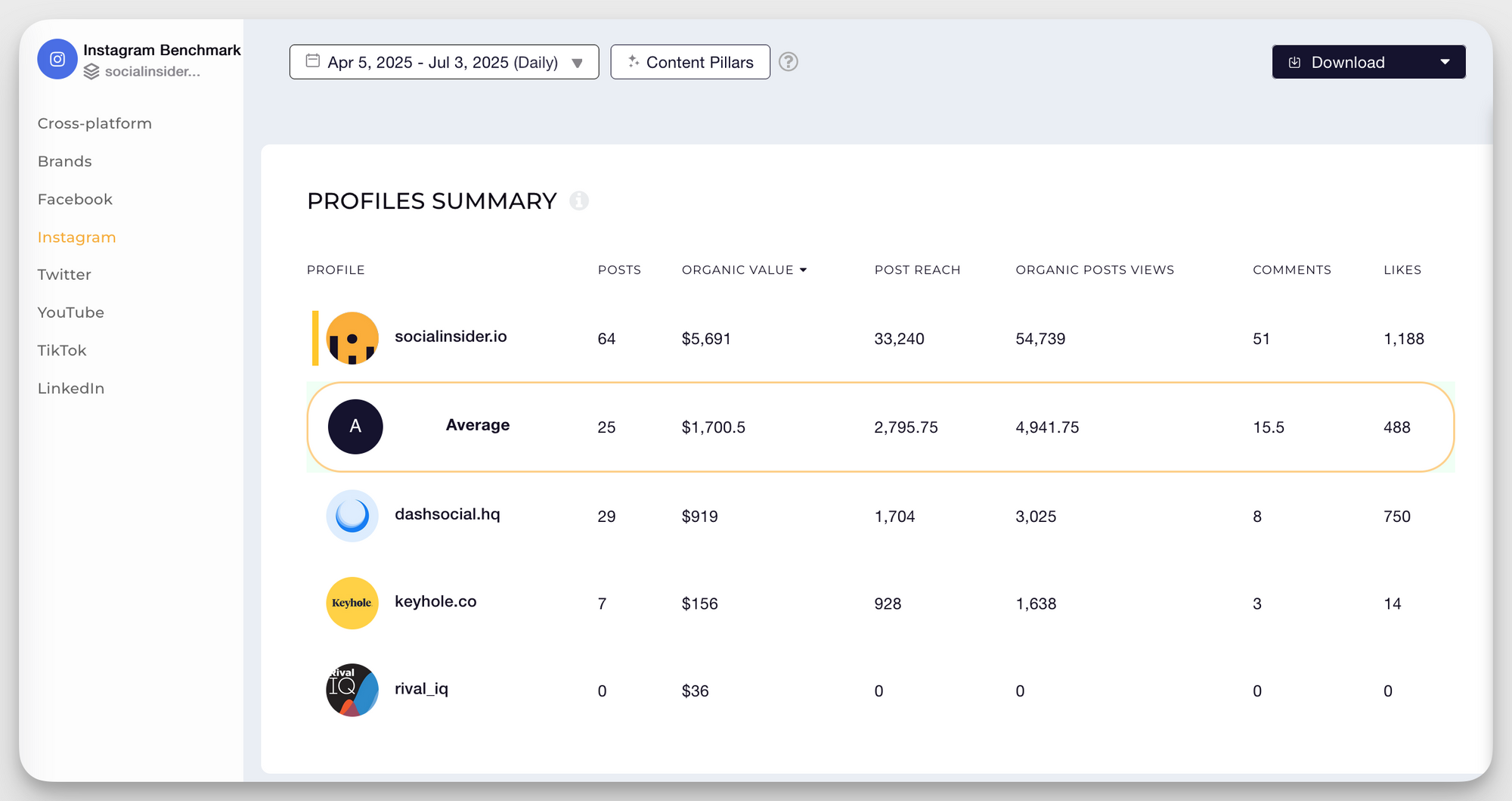
Second, go head-to-head with a specific competitor. Socialinsider breaks down who posts more, what formats they use, how their audience engages, and where you’re outperforming them.
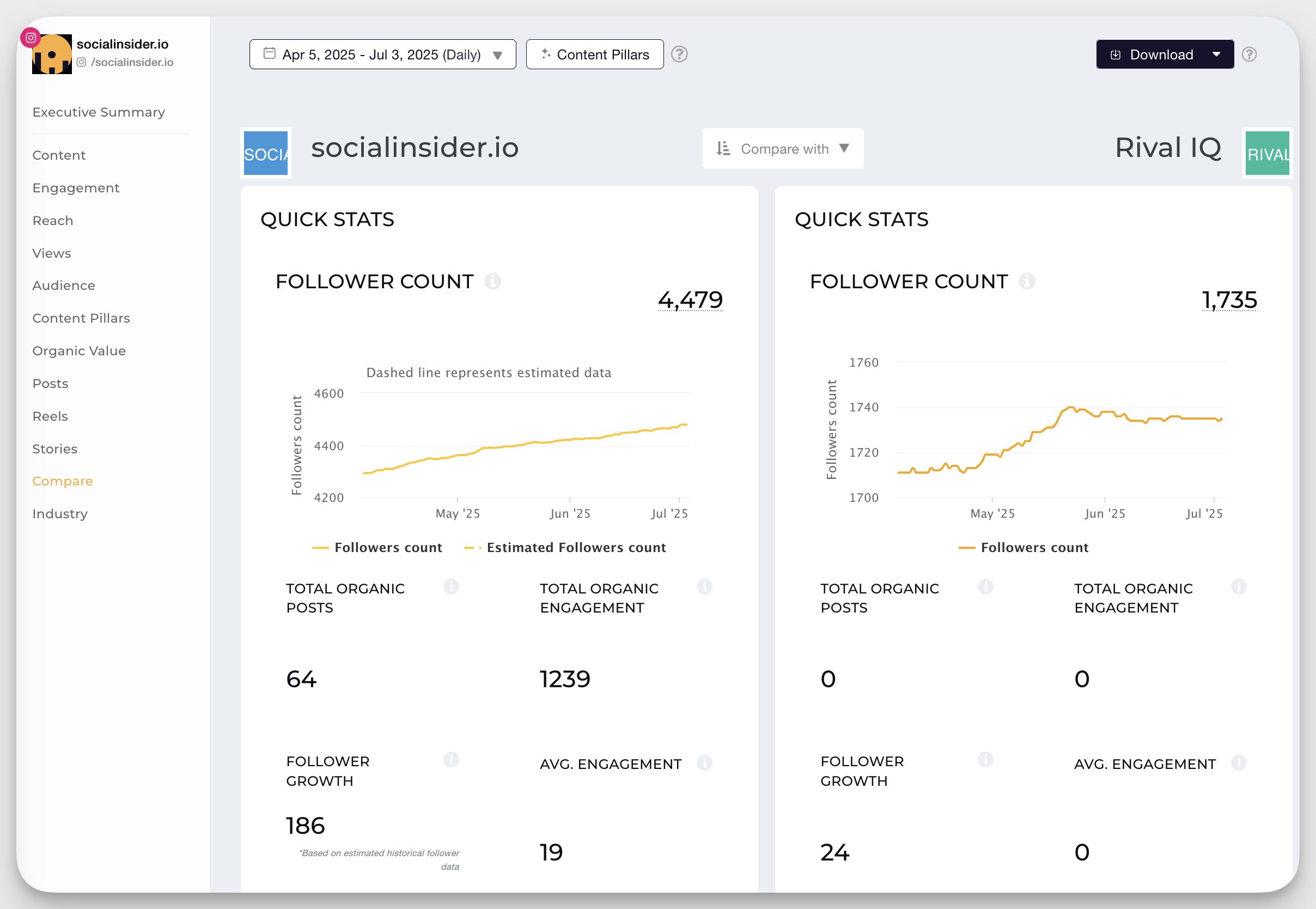
Based on this analysis, you can optimize your social media plan to outperform competitors.
6 AI social media analytics use cases and tools
Here are six ways how to use AI for social media analytics and the AI marketing tools that will help with each use case.
1. Socialinsider for content strategy optimization
Which content format should you focus on? Are there specific content pillars that will get you the most engagement? By running a detailed competitor analysis, AI can help you answer these questions.
Socialinsider lets you track and compare the performance of different content types across your competitors and industry leaders. Here’s how exactly it helps.
- See your competitor’s post breakdown by content pillars and format. Which content pillar is your competitor focusing on? Are they creating more Reels or static image posts? By running an analysis for 2-3 competitors, you can figure out if everyone in your industry is focusing on specific content pillars or formats.
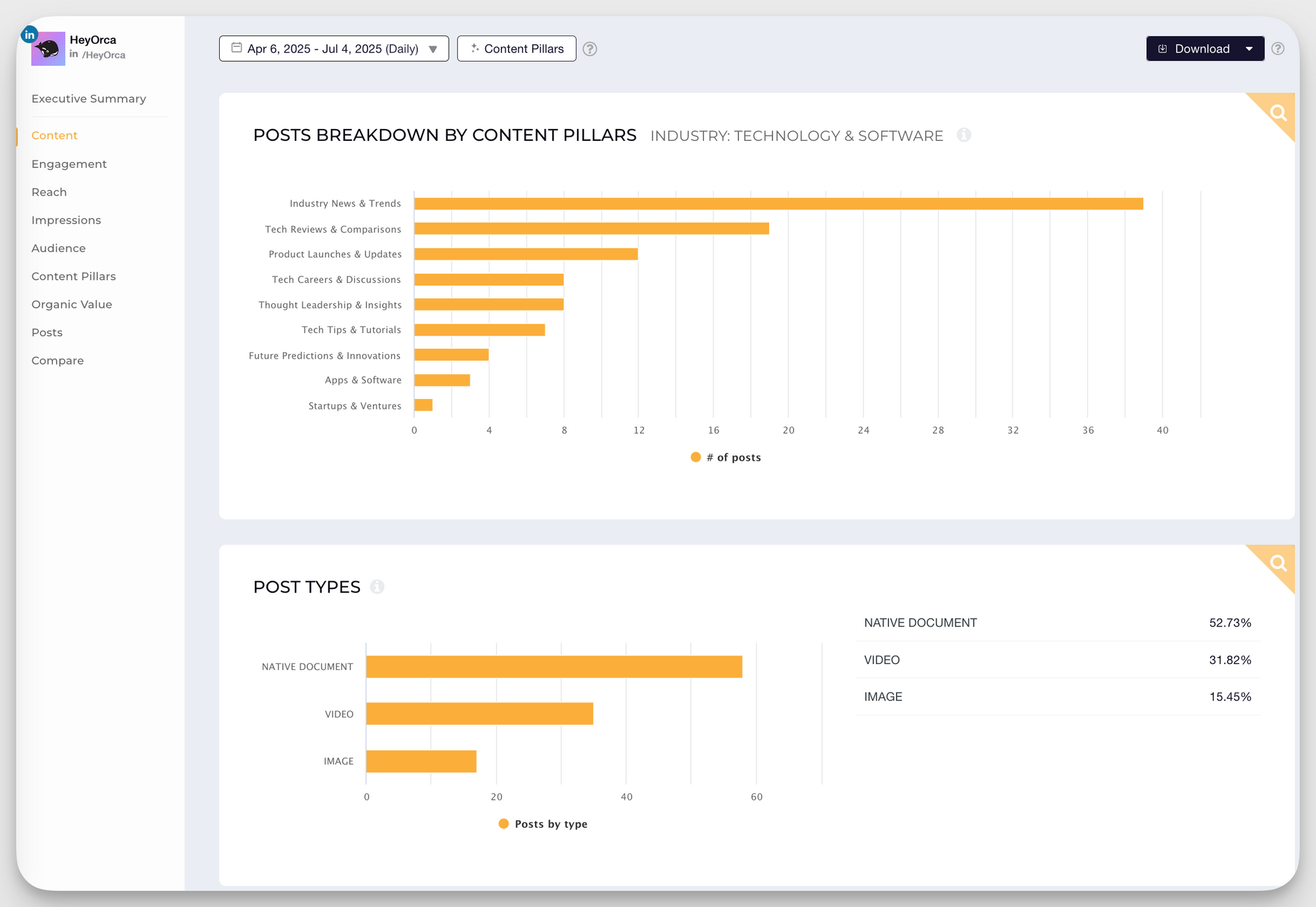
- See post and content pillar breakdown by engagement: Socialinsider lets you track which content pillar gets the most engagement for your competitors. Are you currently prioritizing that content pillar? Based on this analysis, you can optimize your strategies.
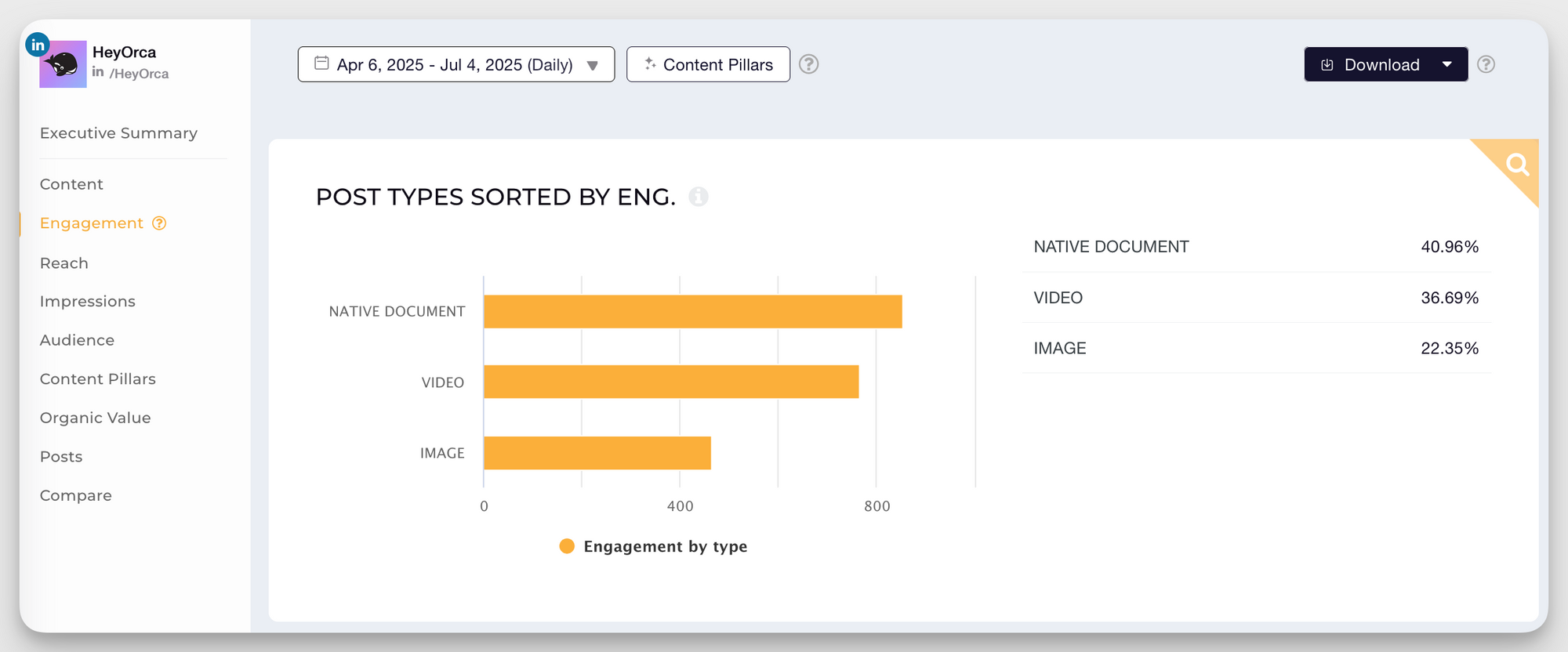
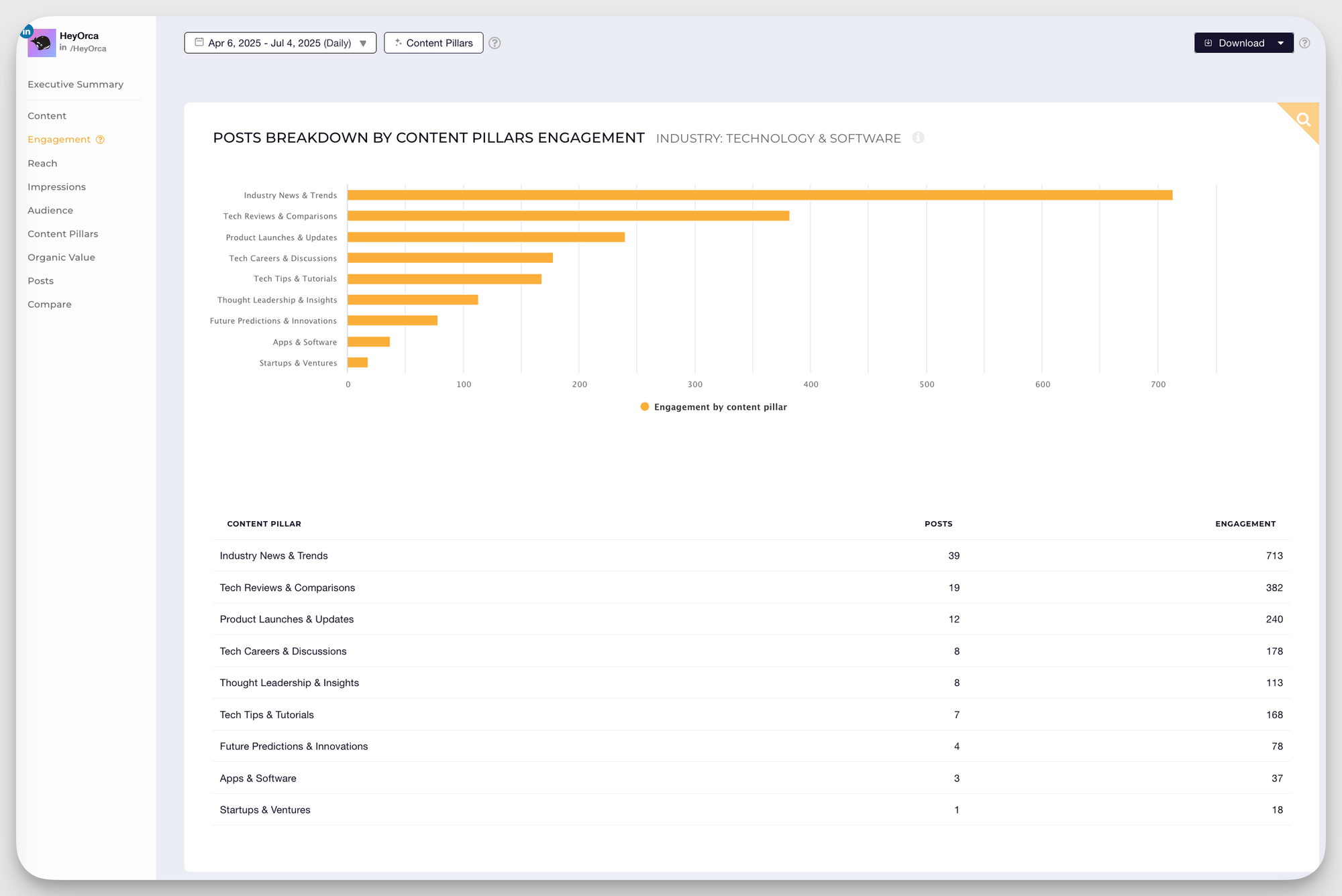
- See their top and bottom-performing content: By looking at your competitors’ top and bottom-performing posts, you can spot what’s clicking (or flopping) with their audience. Use it to borrow winning ideas, avoid their mistakes, and fine-tune your own content strategy.
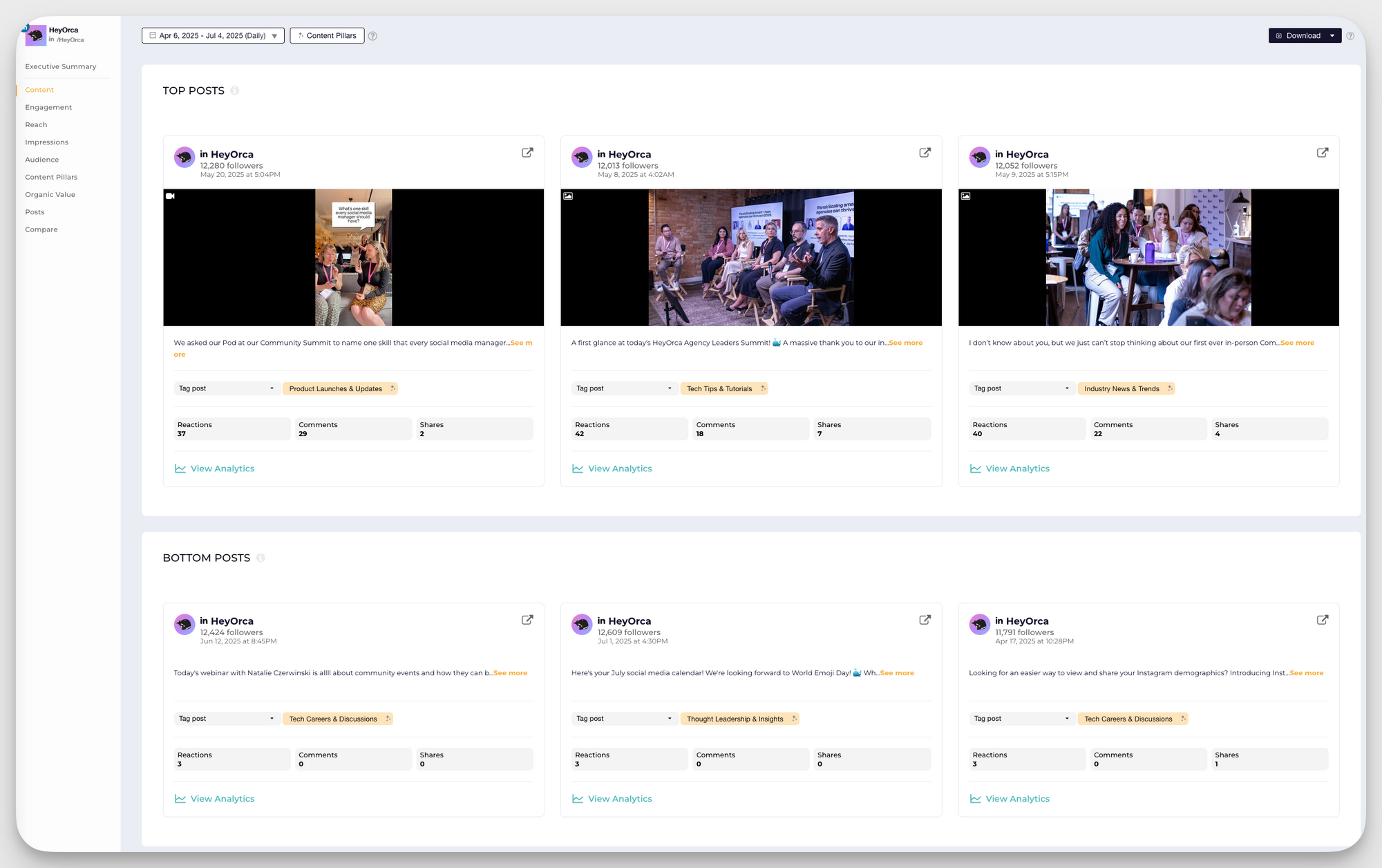
- Tag specific posts and track them: You can tag and track specific types of competitor posts, like event-related content, product launches, or seasonal campaigns. For example, want to know how your competitors handle Black Friday campaigns on Instagram? Tag those posts and study their Instagram marketing strategy. It’s a smart way to spot patterns, learn from their wins, and plan your own campaigns with sharper timing and messaging.
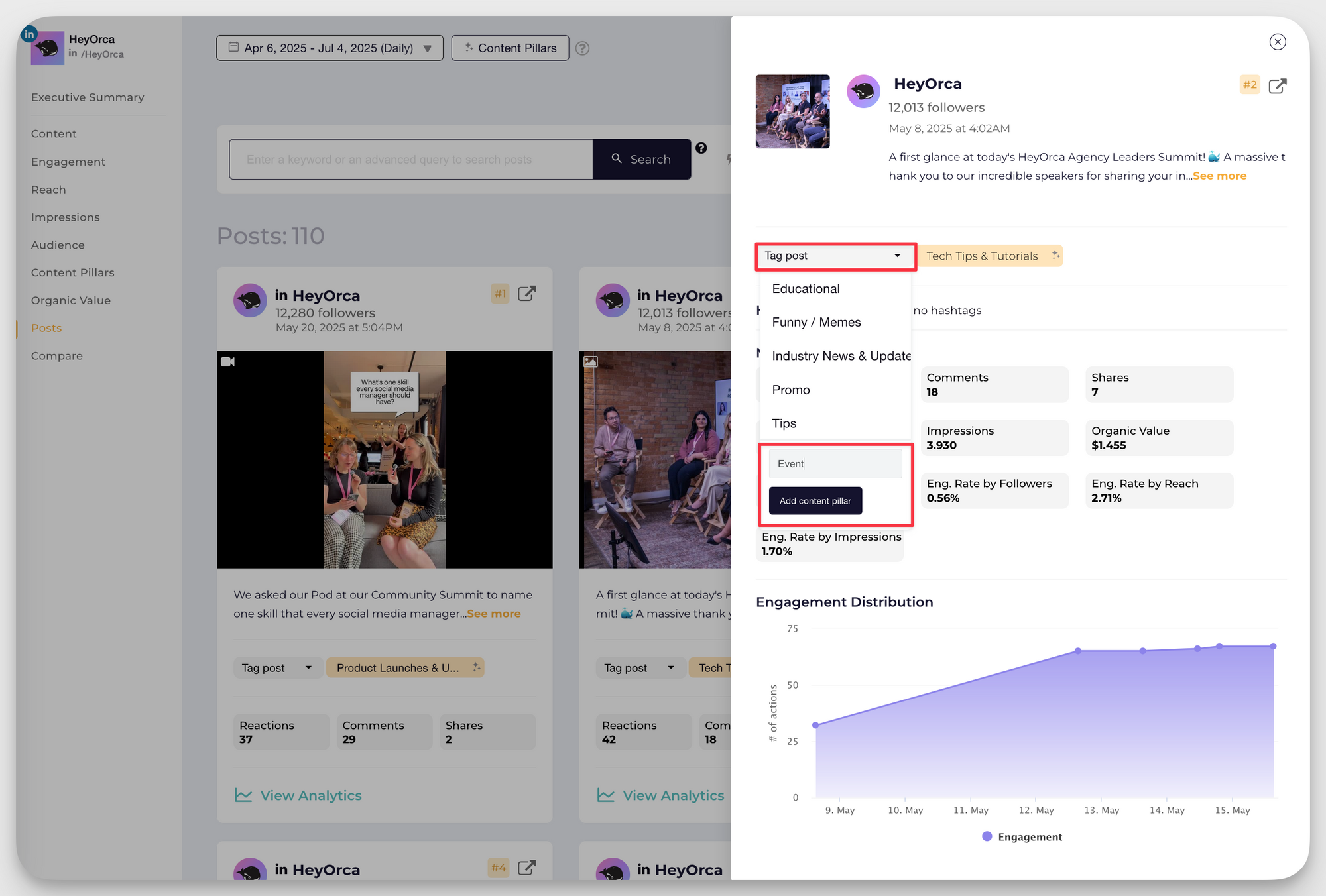
2. Modash for influencer discovery and partnership
Almost every brand on social media knows the power of influencer marketing. But finding influencers manually? Painful. Modash makes it painless and smart. Its AI-powered discovery tool scans every creator on Instagram, TikTok, and YouTube (not just the ones in a database), so you're never stuck with the same recycled shortlist.
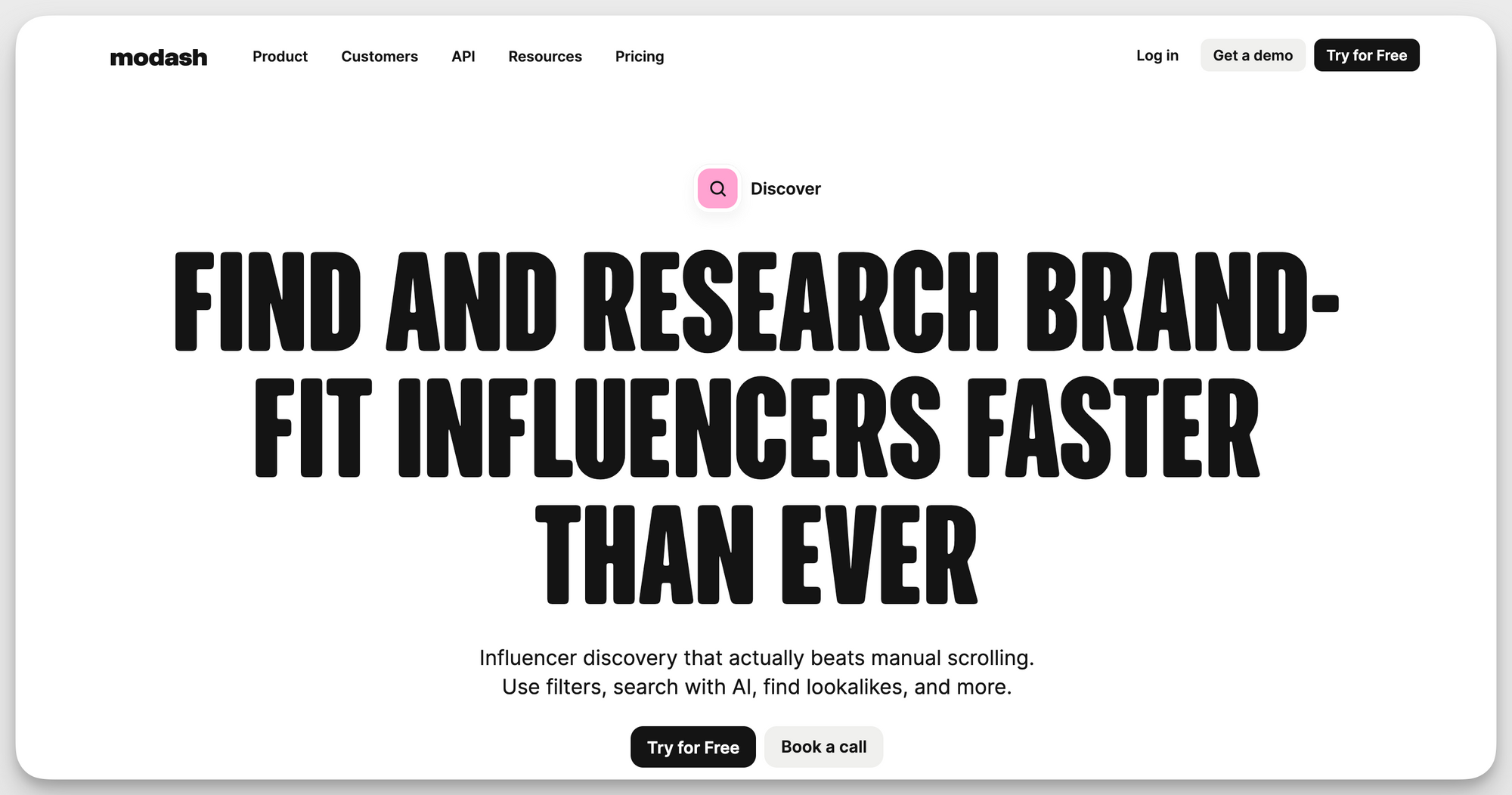
Want micro-influencers in Berlin who talk about skincare and have 5%+ engagement? Modash finds them in seconds. Its AI filters dig deep: audience authenticity, follower location, engagement quality, and even fake follower detection.
You can also track brand mentions automatically, so if someone’s already talking about you, Modash flags them for potential partnerships. No spreadsheets. No guesswork. Just hyper-targeted influencer matches, backed by real data.
3. Reputation for brand reputation management
Reputation does the heavy lifting when it comes to brand reputation management, using AI to catch what humans miss. It monitors reviews, social mentions, and customer feedback across platforms in real time, then uses sentiment analysis to flag shifts in tone: positive, negative, or shady-neutral.
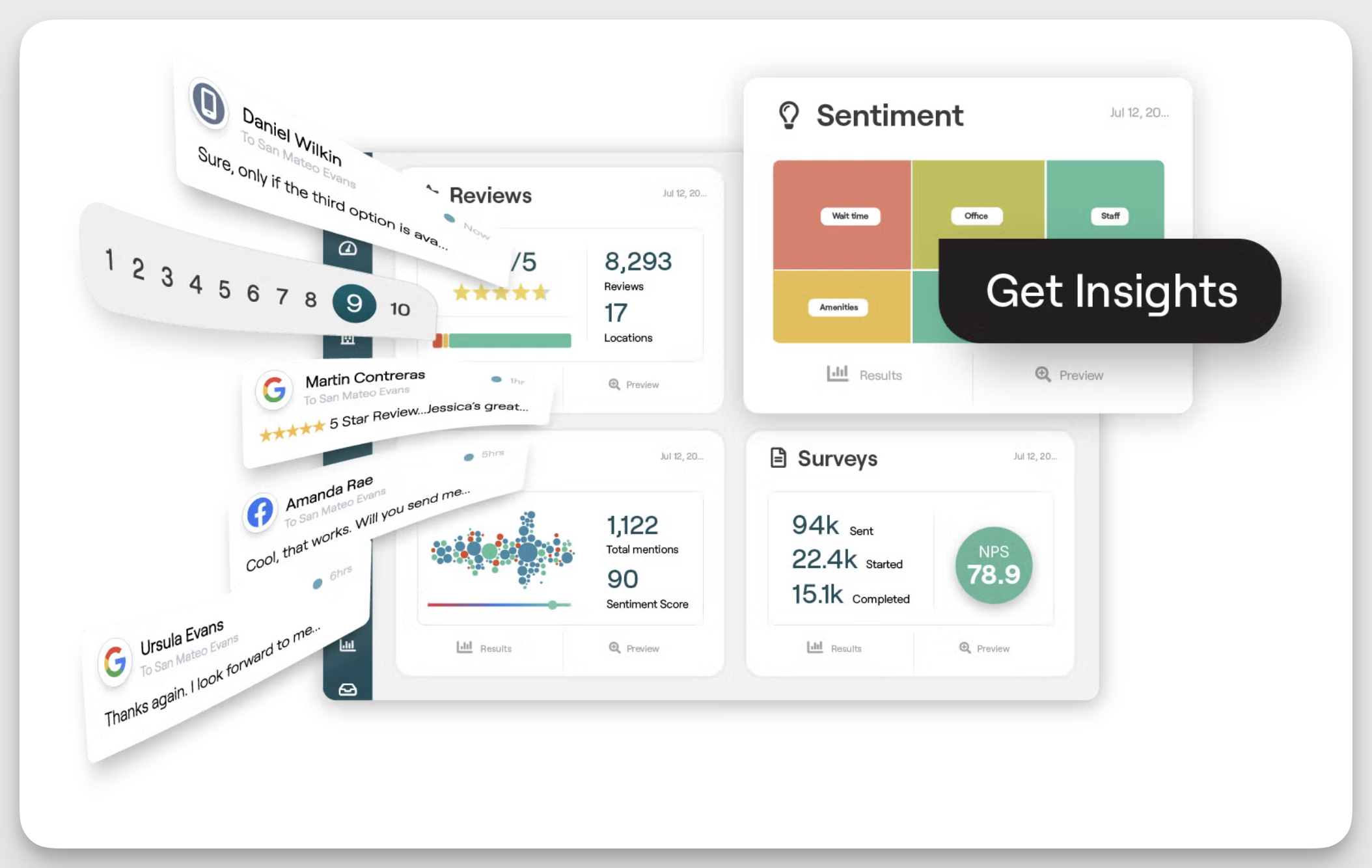
Its AI clusters recurring themes so you can quickly spot patterns (like delivery delays or rude staff complaints) without digging through hundreds of reviews. You also get auto-generated summaries and alerts when there’s a potential PR flare-up, before it hits your inbox or, worse, the news.
Whether it’s spotting a brewing issue or doubling down on what customers love, Reputation helps keep your brand perception sharp, responsive, and one step ahead of the internet mob.
4. Gladly for customer service automation
Gladly helps automate customer service directly on social media. Many times, customers actually message you first on social media. Its AI identifies intent from social DMs and comments, then auto-responds to common queries like order updates, return policies, or store hours without human involvement.
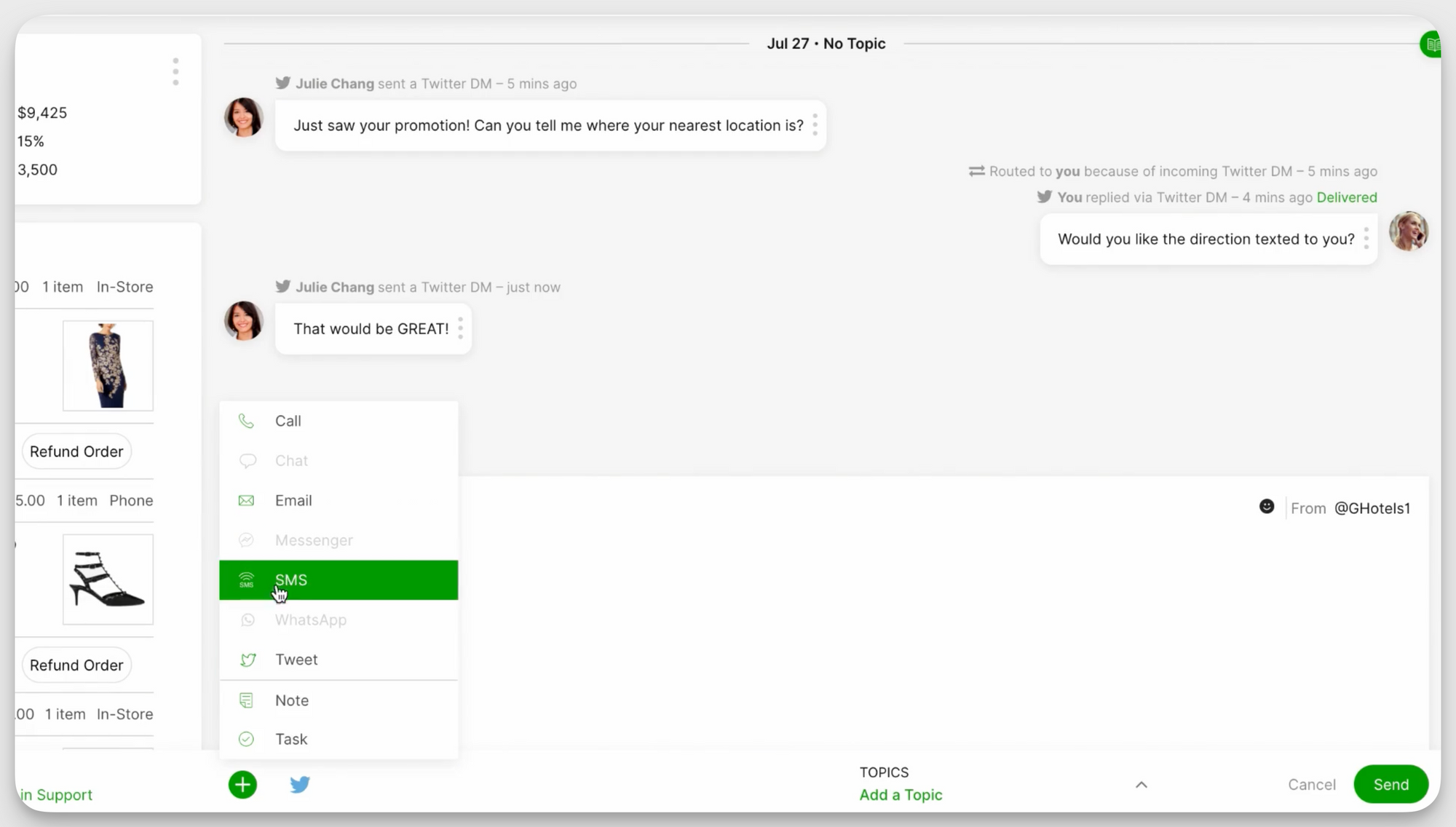
It pulls in full customer history, so if someone complains on Instagram after emailing support, the context is already there, no need to explain twice. AI also auto-routes high-priority messages (like public complaints or product issues) to the right team fast.
Instead of juggling tools or missing DMs, you handle social support in one place, with AI doing the triage. That means faster replies, fewer escalations, and no angry tweets left unread.
5. Google Ads Performance Planner for campaign performance prediction
Wish you could predict if your campaign’s going to flop before you spend the budget? Google Ads Performance Manager makes that a reality. Its AI features analyze historical ad data, audience behavior, and platform trends to forecast how your social media campaigns are likely to perform, even before they launch.
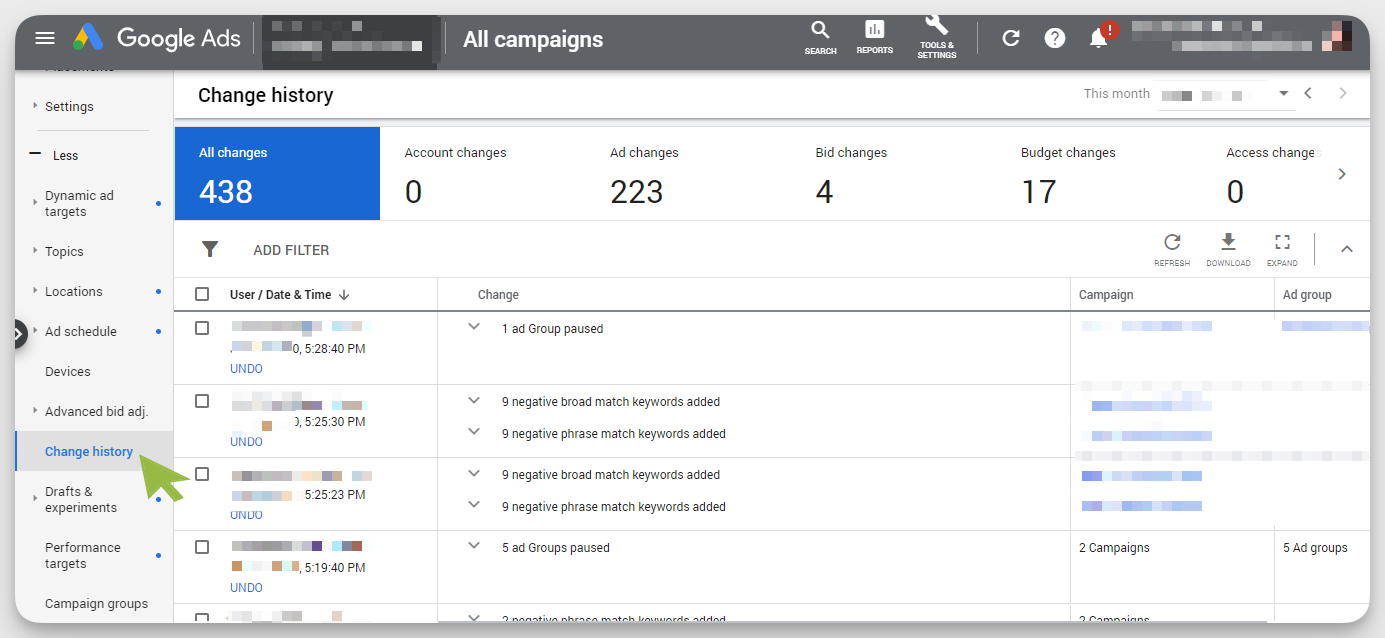
It uses predictive modeling to flag underperforming creatives, suggest better targeting, and optimize bids in real time. The tool also identifies trends in ad fatigue, helping you rotate content before your audience tunes out.
Think of it as your campaign’s risk manager that quietly runs the numbers behind the scenes, so you don’t waste spend on shots in the dark. Less guesswork, more results, and fewer “what went wrong?” meetings.
6. Glassbox for audience behavior analysis
What happens after your audience lands on your website through a social promo? Glassbox helps you go beyond vanity metrics and actually see how users behave after they come from social media. Its AI-powered session replay and journey mapping tools show exactly what social visitors do once they land on your site: where they click, scroll, rage-click, or drop off.
It uses machine learning to detect friction points and patterns at scale, like where users from Instagram abandon carts or where Facebook traffic hits dead ends. Behavioral anomaly detection alerts you when something’s off. Maybe a promo link is broken or the content is confusing.
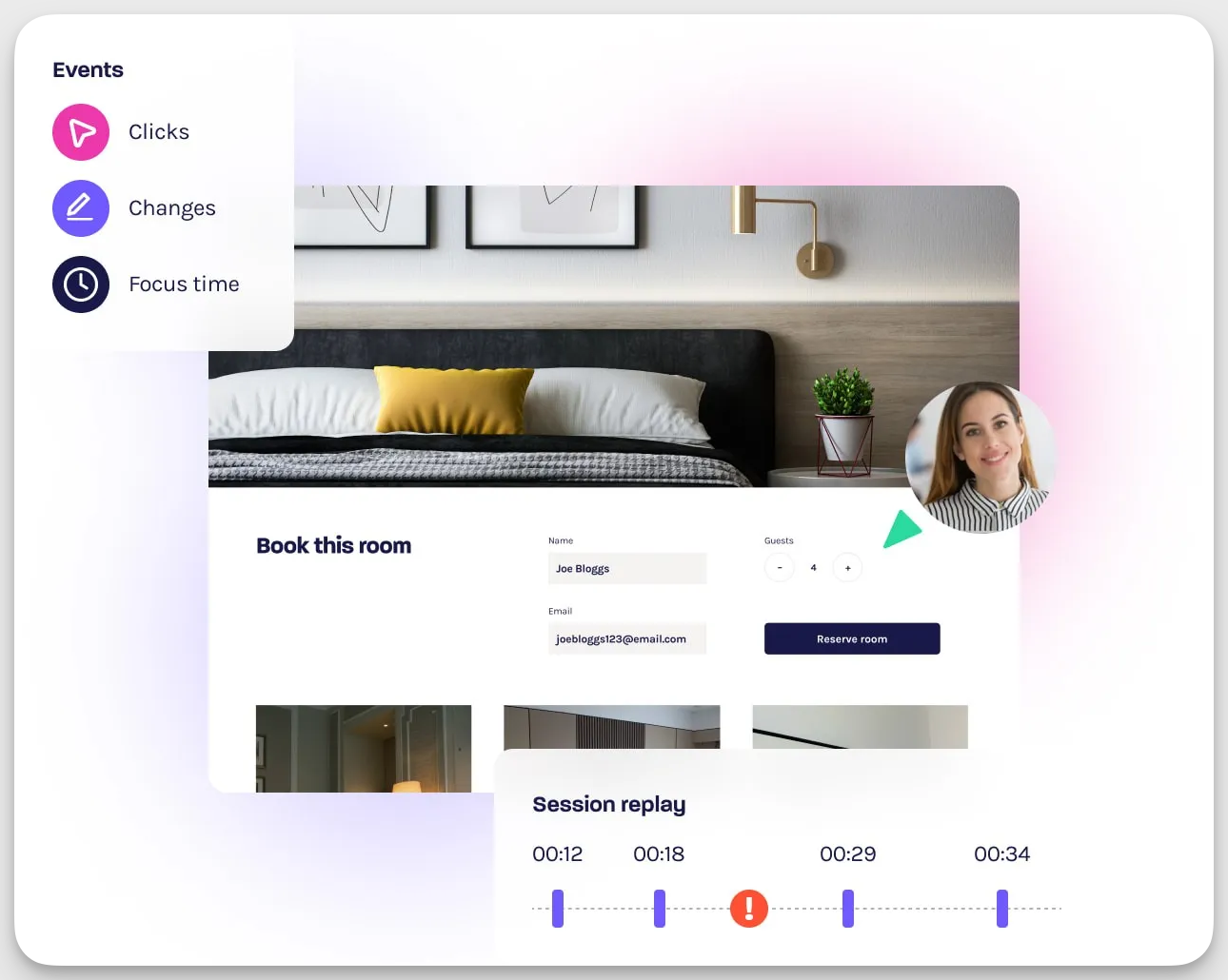
This level of visibility helps you link social traffic to real user behavior. So instead of just tracking clicks, you optimize what happens after the click for better retention and ROI.
AI social media analytics vs. traditional methods
Common challenges and solutions to AI analytics adoption
Moving to AI analytics has its own roadblocks and challenges. Here are four of them and how to deal with each one.
Data integration difficulties
One of the biggest hurdles to using social media AI tools is integration. Your data lives in silos across Instagram, LinkedIn, X, and maybe even third-party tools. AI platforms need clean, connected data to work their magic, and syncing everything can feel like untangling headphone wires.
The fix? Use AI tools (like Socialinsider) that offer cross-platform analytics or native integrations. Or connect everything through APIs and data connectors like Zapier or Supermetrics.
We recommend starting small by linking your most active platforms first, cleaning up the data structure, and then scaling. Once connected, AI can finally give you those cross-platform social media insights you’ve been chasing, with way less manual mess.
ROI measurement challenges
Measuring ROI in AI-powered social media analytics sounds great, until you realize most social media tools don’t actually show you how to calculate it. Likes, reach, and engagement are everywhere, but tying that to real value? That’s the tricky part. Many platforms stop short of showing what your organic content is actually worth in business terms.
That’s where Socialinsider’s Organic Value feature steps in. It estimates the monetary value of your organic posts by comparing them to what you’d pay to get the same reach via paid ads.
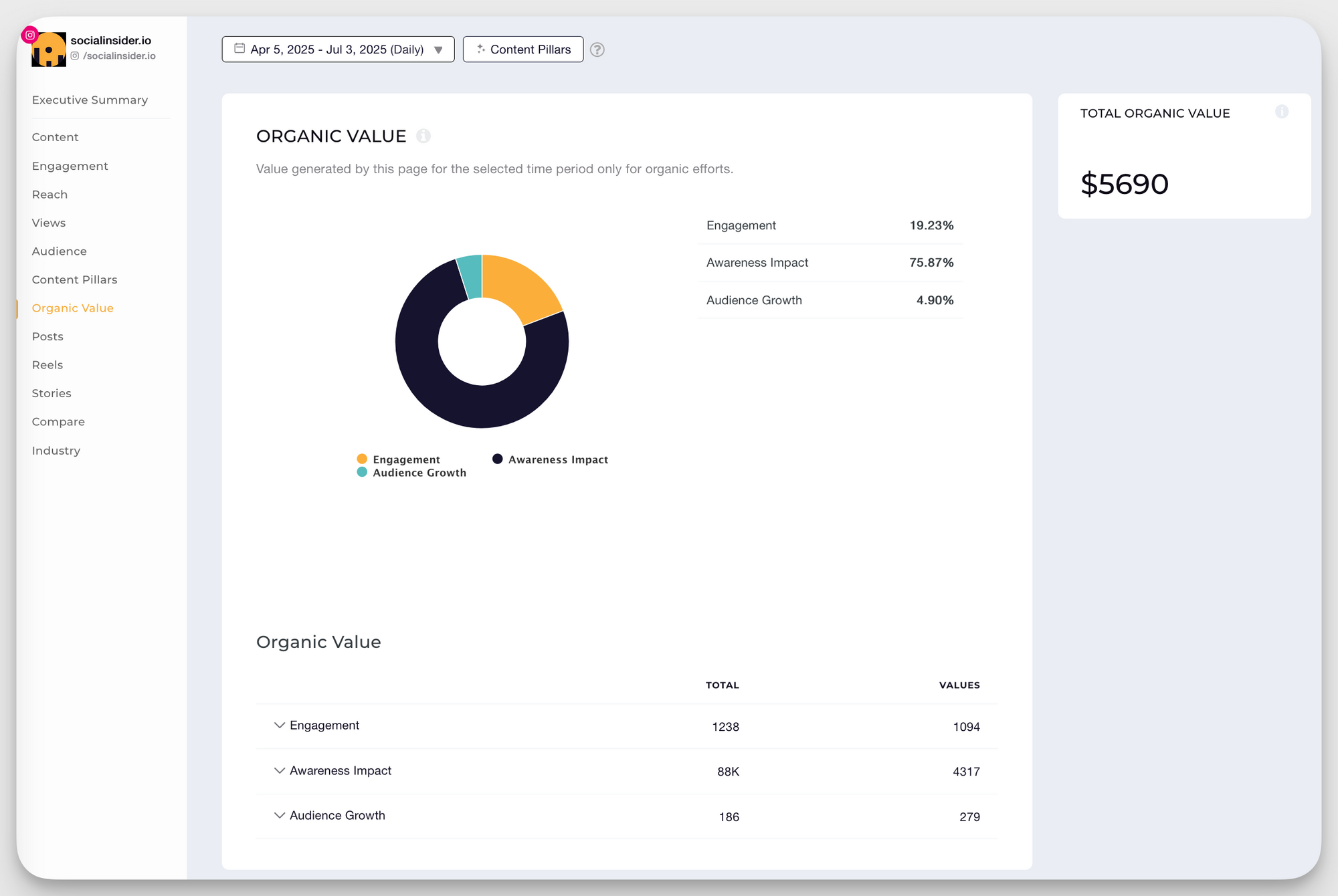
It’s a game-changer for social media managers who constantly get asked, “But what’s the ROI?” Now you’ve got a real number to bring to the table and prove your organic strategy pays off.
Team resistance towards new tool adoption
Worried your team might side-eye the switch to AI analytics? Totally fair. One of the biggest challenges isn’t the tech, it’s the people. Teams used to manual tracking or spreadsheets may resist AI tools because they seem complicated, threaten job routines, or feel like “just another platform to learn.”
The fix? Involve the team early. Show them how AI simplifies their day. For example, faster reporting, fewer repetitive tasks, clearer insights. Start with one tool, one use case (like content benchmarking), and build from there. Also, pick tools with clean, user-friendly dashboards to lower the learning curve.
Once they see the value, resistance usually turns into, “Why didn’t we do this sooner?”
Privacy and ethical considerations
Imagine your AI tool flags a viral post, but it’s based on a private user’s comment or a sensitive topic. Suddenly, you’re in tricky ethical territory. When switching to AI social media analytics, privacy and ethics become a real concern. Many tools pull data from public platforms, but without clear boundaries, it’s easy to overstep by analyzing or acting on information that was never meant for marketing.
The solution? Choose AI tools that are GDPR-compliant and clear about how they handle data. Set internal rules about what data is fair game and how it can be used. Train your team on ethical AI use. Just because the data is accessible doesn’t mean it’s okay to use it.
Final thoughts
AI isn’t here to replace your social media strategy. It’s here to sharpen it. From real-time sentiment tracking to competitor benchmarking and ROI measurement, AI gives you the clarity and speed that manual methods just can’t match.
The brands winning today aren’t the loudest, they’re the smartest with their data. If you’re ready to stop guessing and start acting on insights that actually move the needle, Socialinsider’s AI features are built for you. Get deeper audience understanding, smarter content strategies, and real ROI visibility, all in one place. Subscribe to a free trial of Socialinsider and turn your analytics into action.
FAQs about AI social media analytics
1. How to use AI and data analytics for media relations and social media.
AI and data analytics are transforming how organizations manage media relations and social media by automating monitoring, extracting actionable insights, and enabling real-time engagement. Here’s how you can leverage these technologies:
- Media Monitoring: AI tools scan news outlets, blogs, and social platforms 24/7, alerting you instantly to mentions of your brand, competitors, or industry trends. This allows for rapid response to both opportunities and crises, ensuring you stay ahead in reputation management.
- Sentiment Analysis: AI analyzes the tone of media coverage and social conversations, helping you understand public perception and adjust messaging accordingly.
- Influencer and Competitor Tracking: AI identifies key influencers and tracks competitor activities, providing insights into who is driving conversations and how your brand compares in the media landscape.
- Automated Reporting: AI generates detailed reports on media impact, reach, and ROI, saving time and providing clear evidence of PR effectiveness.
2. How can AI-driven analytics improve social media marketing strategies?
AI-driven analytics enhance social media marketing strategies by providing deep, actionable insights and automating complex tasks:
- Audience Insights: AI analyzes user behavior, preferences, and engagement patterns to identify what content resonates most with your audience. This enables precise audience segmentation and personalized targeting.
- Trend Identification: Machine learning algorithms spot emerging trends and shifts in consumer sentiment, allowing marketers to adapt strategies in real time and stay relevant.
- Predictive Analytics: AI forecasts future engagement and campaign outcomes based on historical data, helping marketers plan content and allocate resources more effectively.
- Performance Optimization: Real-time analytics dashboards track campaign performance, enabling immediate adjustments to maximize results and ROI.
3. How can AI-driven analytics improve social media marketing visibility?
AI-powered analytics boost visibility on social media by optimizing content reach and engagement:
- Content Optimization: AI evaluates which headlines, images, and formats generate the highest engagement, recommending improvements for future posts.
- SEO and Discoverability: AI suggests effective keywords and hashtags, improving organic reach and ensuring content is seen by the right audience.
- Personalized Recommendations: By understanding user interests and behaviors, AI tailors content delivery, increasing the likelihood of shares, likes, and comments.
- Competitor Benchmarking: AI continuously monitors competitors’ social activity, uncovering strategies that drive visibility and identifying gaps you can exploit.
4. How do AI-powered analytics improve social media content strategy?
AI-powered analytics revolutionize content strategy by providing data-driven guidance and automating content creation:
- Content Creation: AI tools generate high-quality, relevant posts by analyzing audience preferences, industry trends, and past performance, ensuring a steady stream of engaging content.
- Sentiment and Topic Analysis: Natural language processing (NLP) breaks down user comments and posts to extract key topics and emotions, guiding content themes and messaging.
- Real-Time Adjustments: AI enables dynamic strategy shifts by providing instant feedback on what’s working and what isn’t, allowing marketers to pivot quickly.
- Visual Content Analysis: AI assesses images and videos for elements that drive engagement, helping marketers fine-tune creative assets for maximum impact.
Analyze your competitors in seconds
Track & analyze your competitors and get top social media metrics and more!
You might also like
Improve your social media strategy with Socialinsider!
Use in-depth data to measure your social accounts’ performance, analyze competitors, and gain insights to improve your strategy.





